
Europe will launch a spacecraft to Jupiter. Here’s how to watch. (Image Credit: Mashable)
Europe is about to send a spacecraft on an epic quest to study Jupiter’s icy moons, a mission that won’t begin in earnest for another eight years when it finally reaches its deep space destination.
The so-called “Juice” mission is intended to focus its research on Europa, Callisto, and particularly Ganymede, three large moons orbiting the gas giant planet a half-billion miles away. These moons(Opens in a new tab) have intrigued scientists for years, because they’re thought to have liquid oceans trapped beneath icy shells.
Ganymede is the largest moon in the solar system and the only one known to have its own magnetic field, according to the European Space Agency (ESA). The mission will explore(Opens in a new tab) these worlds and investigate whether life could have ever flourished in this realm.
The ESA will attempt to launch Juice(Opens in a new tab) on an Ariane 5 rocket from its spaceport in French Guiana on the South American continent. It will be the space agency’s last time using the rocket before it transitions to a new propulsion system. Liftoff is slated for 8:15 a.m. EST / 14:15 CEST Thursday April 13.
Tweet may have been deleted
(opens in a new tab)
(Opens in a new tab)
To understand the possibility of habitability, scientists need to explore the Jupiter system as a whole, said Olivier Witasse, a Juice mission scientist, during a recent ESA news conference. That means learning as much as they can about Jupiter’s atmosphere and weather, strong rotating magnetic field, the volcanic moon Io, the other moons, and how they’re all interconnected.
Want more science and tech news delivered straight to your inbox? Sign up for Mashable’s Top Stories newsletter today.
“Jupiter, it’s really a miniaturized solar system,” Witasse said. “It’s the key to understand our own solar system — how it was formed, how it evolved with time.”

Credit: ESA illustration
Tweet may have been deleted
(opens in a new tab)
(Opens in a new tab)
Before reaching Jupiter, the spacecraft will make flybys of Earth and Venus to get enough energy to slingshot to the outer solar system, reaching Jupiter in 2031(Opens in a new tab). If successful, it will be the first time in history a spacecraft has ever orbited a moon other than Earth’s when it loops around Ganymede in 2034. NASA and the Japanese and Israeli space agencies have contributed scientific instruments for the mission.
Jupiter’s “really a miniaturized solar system.”
“Juice” is a wonky acronym for Jupiter Icy Moons Explorer(Opens in a new tab), fitting for Ganymede’s mythological namesake, who served as Jupiter’s personal cupholder(Opens in a new tab). The study seeks to answer several key questions: How do gas giants like Jupiter function; how did Jupiter’s moons form; could there have been life on or around Jupiter in its past or even now; what are these oceanic moons like; and what makes Ganymede so different?

Credit: NASA / ESA / Hubble / E. Karkoschka
One of the biggest challenges for the mission was designing a spacecraft and instruments for the unusual environment around Jupiter. Particles from the volcanic moon Io are trapped by Jupiter’s potent magnetic field, creating extreme radiation.
“We really had to put all the most sensitive equipment inside vaults, literally boxes lined with lead, that will stop most of the radiation from reaching the electronics,” said Alessandro Atzei, the payload system engineer.
The launch will be streamed live on ESA Web TV(Opens in a new tab) and YouTube(Opens in a new tab), from 7:45 — 10:05 a.m. EST. A post-launch briefing is planned to follow at 10:30 a.m. EST.
If the mission is delayed, the ESA team can try again once daily for the rest of April.





